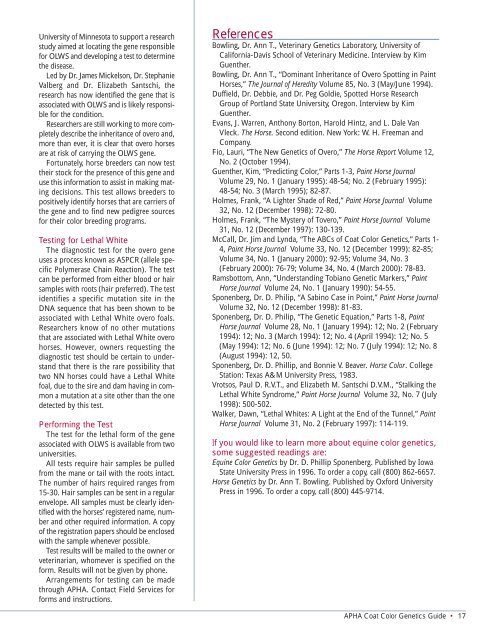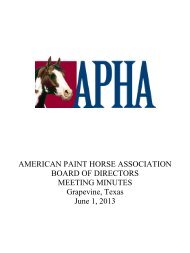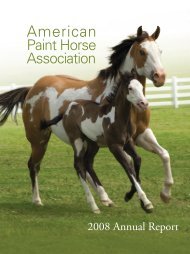Coat Color Genetics - Press - American Paint Horse Association
Coat Color Genetics - Press - American Paint Horse Association
Coat Color Genetics - Press - American Paint Horse Association
You also want an ePaper? Increase the reach of your titles
YUMPU automatically turns print PDFs into web optimized ePapers that Google loves.
University of Minnesota to support a research<br />
study aimed at locating the gene responsible<br />
for OLWS and developing a test to determine<br />
the disease.<br />
Led by Dr. James Mickelson, Dr. Stephanie<br />
Valberg and Dr. Elizabeth Santschi, the<br />
research has now identified the gene that is<br />
associated with OLWS and is likely responsible<br />
for the condition.<br />
Researchers are still working to more completely<br />
describe the inheritance of overo and,<br />
more than ever, it is clear that overo horses<br />
are at risk of carrying the OLWS gene.<br />
Fortunately, horse breeders can now test<br />
their stock for the presence of this gene and<br />
use this information to assist in making mating<br />
decisions. This test allows breeders to<br />
positively identify horses that are carriers of<br />
the gene and to find new pedigree sources<br />
for their color breeding programs.<br />
Testing for Lethal White<br />
The diagnostic test for the overo gene<br />
uses a process known as ASPCR (allele specific<br />
Polymerase Chain Reaction). The test<br />
can be performed from either blood or hair<br />
samples with roots (hair preferred). The test<br />
identifies a specific mutation site in the<br />
DNA sequence that has been shown to be<br />
associated with Lethal White overo foals.<br />
Researchers know of no other mutations<br />
that are associated with Lethal White overo<br />
horses. However, owners requesting the<br />
diagnostic test should be certain to understand<br />
that there is the rare possibility that<br />
two NN horses could have a Lethal White<br />
foal, due to the sire and dam having in common<br />
a mutation at a site other than the one<br />
detected by this test.<br />
Performing the Test<br />
The test for the lethal form of the gene<br />
associated with OLWS is available from two<br />
universities.<br />
All tests require hair samples be pulled<br />
from the mane or tail with the roots intact.<br />
The number of hairs required ranges from<br />
15-30. Hair samples can be sent in a regular<br />
envelope. All samples must be clearly identified<br />
with the horses’ registered name, number<br />
and other required information. A copy<br />
of the registration papers should be enclosed<br />
with the sample whenever possible.<br />
Test results will be mailed to the owner or<br />
veterinarian, whomever is specified on the<br />
form. Results will not be given by phone.<br />
Arrangements for testing can be made<br />
through APHA. Contact Field Services for<br />
forms and instructions.<br />
References<br />
Bowling, Dr. Ann T., Veterinary <strong>Genetics</strong> Laboratory, University of<br />
California-Davis School of Veterinary Medicine. Interview by Kim<br />
Guenther.<br />
Bowling, Dr. Ann T., “Dominant Inheritance of Overo Spotting in <strong>Paint</strong><br />
<strong>Horse</strong>s,” The Journal of Heredity Volume 85, No. 3 (May/June 1994).<br />
Duffield, Dr. Debbie, and Dr. Peg Goldie, Spotted <strong>Horse</strong> Research<br />
Group of Portland State University, Oregon. Interview by Kim<br />
Guenther.<br />
Evans, J. Warren, Anthony Borton, Harold Hintz, and L. Dale Van<br />
Vleck. The <strong>Horse</strong>. Second edition. New York: W. H. Freeman and<br />
Company.<br />
Fio, Lauri, “The New <strong>Genetics</strong> of Overo,” The <strong>Horse</strong> Report Volume 12,<br />
No. 2 (October 1994).<br />
Guenther, Kim, “Predicting <strong>Color</strong>,” Parts 1-3, <strong>Paint</strong> <strong>Horse</strong> Journal<br />
Volume 29, No. 1 (January 1995): 48-54; No. 2 (February 1995):<br />
48-54; No. 3 (March 1995); 82-87.<br />
Holmes, Frank, “A Lighter Shade of Red,” <strong>Paint</strong> <strong>Horse</strong> Journal Volume<br />
32, No. 12 (December 1998): 72-80.<br />
Holmes, Frank, “The Mystery of Tovero,” <strong>Paint</strong> <strong>Horse</strong> Journal Volume<br />
31, No. 12 (December 1997): 130-139.<br />
McCall, Dr. Jim and Lynda, “The ABCs of <strong>Coat</strong> <strong>Color</strong> <strong>Genetics</strong>,” Parts 1-<br />
4, <strong>Paint</strong> <strong>Horse</strong> Journal Volume 33, No. 12 (December 1999): 82-85;<br />
Volume 34, No. 1 (January 2000): 92-95; Volume 34, No. 3<br />
(February 2000): 76-79; Volume 34, No. 4 (March 2000): 78-83.<br />
Ramsbottom, Ann, “Understanding Tobiano Genetic Markers,” <strong>Paint</strong><br />
<strong>Horse</strong> Journal Volume 24, No. 1 (January 1990): 54-55.<br />
Sponenberg, Dr. D. Philip, “A Sabino Case in Point,” <strong>Paint</strong> <strong>Horse</strong> Journal<br />
Volume 32, No. 12 (December 1998): 81-83.<br />
Sponenberg, Dr. D. Philip, “The Genetic Equation,” Parts 1-8, <strong>Paint</strong><br />
<strong>Horse</strong> Journal Volume 28, No. 1 (January 1994): 12; No. 2 (February<br />
1994): 12; No. 3 (March 1994): 12; No. 4 (April 1994): 12; No. 5<br />
(May 1994): 12; No. 6 (June 1994): 12; No. 7 (July 1994): 12; No. 8<br />
(August 1994): 12, 50.<br />
Sponenberg, Dr. D. Phillip, and Bonnie V. Beaver. <strong>Horse</strong> <strong>Color</strong>. College<br />
Station: Texas A&M University <strong>Press</strong>, 1983.<br />
Vrotsos, Paul D. R.V.T., and Elizabeth M. Santschi D.V.M., “Stalking the<br />
Lethal White Syndrome,” <strong>Paint</strong> <strong>Horse</strong> Journal Volume 32, No. 7 (July<br />
1998): 500-502.<br />
Walker, Dawn, “Lethal Whites: A Light at the End of the Tunnel,” <strong>Paint</strong><br />
<strong>Horse</strong> Journal Volume 31, No. 2 (February 1997): 114-119.<br />
If you would like to learn more about equine color genetics,<br />
some suggested readings are:<br />
Equine <strong>Color</strong> <strong>Genetics</strong> by Dr. D. Phillip Sponenberg. Published by Iowa<br />
State University <strong>Press</strong> in 1996. To order a copy, call (800) 862-6657.<br />
<strong>Horse</strong> <strong>Genetics</strong> by Dr. Ann T. Bowling. Published by Oxford University<br />
<strong>Press</strong> in 1996. To order a copy, call (800) 445-9714.<br />
APHA <strong>Coat</strong> <strong>Color</strong> <strong>Genetics</strong> Guide • 17




